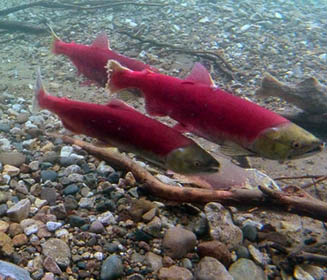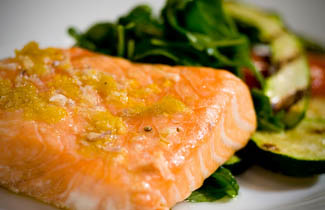Sockeye salmon Nutrition facts
Sockeye salmon is the important Pacific salmonidae species living in cool, clean waters of the North Pacific Ocean and rivers discharging into it.
Flavorful and delicious, Sockeye's pinkish-orange flesh is a rich source of carotenoid astaxanthin, fat-soluble vitamins, and omega-3 fatty acids.
Sockeye salmon belong to the Salmonidae family of ray-finned fish in the Genus: Oncorhynchus.
Scientific name: Oncorhynchus nerka, which means a characteristic pointed snout feature of the spawning-phase sockeye.
Common names: Red salmon, Blueback salmon, Redfish, Summer Sockeye, Benizake (紅鮭), etc.
 |
| Sockeye salmon in Tazimina Lake. Courtesy: Lake Clark National Park & Preserve |
Description:
The name sockeye salmon refers to "Suk-kegh," meaning “red-fish” in the native Halkomelem language of Alaskan inhabitants.
Sockeye features a fusiform, streamlined, laterally compressed body enabling long-distance marine migration and upstream run.
Sea-going sockeye are dark steel blue to greenish-blue on the top (giving them their "blueback" name), iridescent silvery sides, and white belly. Some individuals may exhibit dark speckling and irregular marks on the dorsal fin.
As sockeye returns to their freshwater spawning grounds, their heads turn olive green, and their bodies turn bright red, hence their name, “red” salmon.
Male sockeye develops a humped back and hooked jaws filled with tiny, visible teeth.
Average length 18 in. and weigh 5–15 lb. Lifespan is about 4-5 years.
Kokanee salmon
Some sockeyes do not migrate to the ocean and live their entire lives in freshwater lakes. These landlocked sockeyes are known as the Kokanee in the local Salish language. They are much smaller in size and measure about 10-12 In.
Biology
Sockeye salmon are anadromous fish. In the spring, fry emerge from the nest, and go to the sea during their first summer before migrating to the ocean. They grow quickly in size and return as adults to natal streams to spawn in the summer.
Just before spawning, the female selects a suitable ground, usually with a gravel bottom, and digs a nest with its tail.
The female is then attended by a dominant male and sometimes a few subordinate males.
All adult sockeye die after spawning.
Habitat
Sockeye is the smallest of Pacific salmons. In a way similar to other salmon species. They are migratory fish completing their fascinating journey from natal freshwater streams, rivers, lakes, and deep ocean waters and back again to their natal waters to spawn and die.
Sockeye habitat requires cold, clean, oxygenated water to survive as warm ocean temperatures increase the energy expenditure during the migration and produce fewer eggs on the spawning grounds.
Fry feed primarily on zooplankton, fish larvae, and insects, whereas adults largely depend upon marine zooplankton, krill, insects, and small crustaceans.
Health Benefits of Sockeye salmon
Sockeye salmon has relatively fewer calories than other salmon varieties. It holds 131 cal/3.5 Oz in comparison to 179/3.5 Oz calories in Chinook Salmon.
American Heart Association recommends consumption of at least 2 servings of oily fish like sockeye to fulfill requirements of essential fatty acids, protein, minerals, and fat-soluble vitamins.
The characteristic pink or orange-red color of sockeye salmon flesh comes from the fat-soluble carotenoid pigment astaxanthin, which normally exists in crustacean flesh like shrimp.
Astaxanthin is a biologically stable antioxidant, several hundred times more powerful than vitamin C and Co-enzyme Q10.
Sockeye flaky orange-pink flesh is a rich source of vitamins A, D, and E and long-chain omega-3 fatty acids (PUFA).
It is an excellent source of protein; 3.5 Oz of sockeye meat provides 22.2 g (39.6% of daily required levels). Its flesh is complete in the sense that it composes all the essential amino acids required for optimal growth and development.
Sockeye fish is good source of omega-3 eicosapentaenoicacid (EPA), docosapantaenoicacid (DPA) and docosahexaenoic acid (DHA) fatty acids. Research studies suggest that these fatty acids, particularly DHA, play an important role in the development of neural systems, especially in infants and children.
In adults, several large trials have evaluated the effect of fish or fish oils on heart disease. In the "GISSI Prevention Trial, heart attack survivors who took a 1-gram capsule of omega-3 fats every day for three years were less likely to have a repeat heart attack, stroke, or die of sudden death than those who took a placebo".
It is one of the finest sources of some B-complex vitamins such as niacin (vitamin B3: provides 53% RDI/100 g), pyridoxine, and riboflavin.
Sockeye filets compose 162 IU/3.5 Oz of Vitamin-A. vitamin-A and omega-3 are essential for healthy mucosa and skin.
100 g (3.5 Oz) of sockeye holds 563 IU of vitamin D; about 94% of daily recommended intake. Vitamin D plays an important role in the calcium metabolism and offers protection from cancers.
The Food and Drug Administration (FDA) recommends that pregnant women can eat at least 8 ounces and up to 12 ounces (340 grams) of a variety of seafood lower in mercury a week.
Furthermore, sockeye composes significant amounts of essential minerals like calcium, phosphorus, and magnesium. In this marine fish, the other trace elements commonly found are selenium and iodine.
| Principle | Nutrient Value | Percent of RDA |
|---|---|---|
| Energy | 131 Kcal | 6.5% |
| Carbohydrates | 0 g | 0% |
| Protein | 22.2 g | 39.6% |
| Total Fat | 4.69 g | 23.5% |
| Cholesterol | 51 mg | 17% |
| Dietary Fiber | 0 g | 0% |
| Vitamins | ||
| Folates | 6 μg | 1.5% |
| Niacin | 8.51 mg | 53% |
| Pyridoxine | 0.731 mg | 58.5% |
| Riboflavin | 0.207 mg | 16% |
| Thiamin | 0.132 mg | 11% |
| Vitamin-A | 162 IU | 5.4% |
| Vitamin-C | 0 mg | 0% |
| Vitamin-D | 563 IU | 94% |
| Vitamin-E | 0.83 mg | 5.5% | Electrolytes |
| Sodium | 78 mg | 5.2% |
| Potassium | 367 mg | 7.8% |
| Minerals | ||
| Calcium | 9 mg | 0.9% |
| Iron | 0.43 mg | 5% |
| Magnesium | 30 mg | 7.5% |
| Phosphorus | 257 mg | 37% |
| Zinc | 0.46 mg | 4% |
| Omega-3 fats (PUFA) | ||
| EPA (20:5 n-3) | 0.251 g | -- |
| DPA (22:5 n-3) | 0.079 g | -- |
| DHA (22:6 n-3) | 0.471 g | -- |
Buying
Sockeye is always caught wild in the Alaskan waters and is almost never farmed, unlike the Atlantic salmon.
In the US Sockeye salmon is normally sold canned, however, frozen with skin-on filets, smoked, salt-cured, and dried versions are also readily available. One can buy either whole or dressed into steaks, roasts, and fillets.
Look for labeling on the package “sustainable seafood.” Avoid the product with a strong ammonia odor. Avoid smoked salmon with dried or brown edges that appear leaky and wet.
Storage
Sockeye goes bad quickly if not cold-stored properly after the harvest as its oily-flesh flesh attracts bacteria. Store whole fish, fillets, steaks, and chunks in the freezer section.
Preparation
Sockeye is highly prized for its rich color, flavorfulness, firm, flaky, and oily flesh. The flesh close to the head is more delicate than the flesh nearer the tail. If you prefer to skin, just peel it inside out. Remove any bones before cooking.
Sockeye salmon may be pan-roasted, shallow fried, broiled, foil-baked, and grilled in a variety of mouth-watering menus.
Just ensure it should be cooked until the meat is opaque and flakes off easily.
Here are some serving ideas:
 |
| Sockeye salmon recipe. Credit: Breville USA |
Marinate wild-caught sockeye fillets in olive oil and herbs (minced garlic, thyme, parsley, and peppercorns) for an hour. Then bake or grill and serve with lemon wedges.
Enjoy pan-seared filets with herbs and lemon juice.
Canned sockeye employed in sandwiches, salads, omelets, pasta dishes, mousses, and quiches.
Sockeye salmon is known as red salmon (benizake-紅鮭) in Japanese. Salted salmon or shiozake (塩鮭) is a favorite Japanese breakfast.
Mainly imported from the U.S., it is widely used in sushi and sashimi restaurants across Japan.
Sockeye salmon roe –salmon caviar (ikura) and roe in the sac (sujiko) enjoyed as toppings in sushi, and rice dishes in Japan.
Safety profile
Methyl mercury levels in Sockeye salmon is 0.022 Parts Per Million (PPM). Accordingly, the U.S FDA final guidelines on how much fish expectant as well as breastfeeding mothers can eat, along with lists of specific options that are safe or should be avoided, places Sockeye in the best choice category.
By this yardstick, one can consume 2-3 servings a week. (Medical disclaimer).
Also read ≻≻-
≻≻- Chinook Salmon nutrition facts and health benefits.
≻≻- Atlantic Cod nutrition facts and health benefits.
≻≻- Brook trout nutrition facts and health benefits.
≻≻- Halibut nutrition facts and health benefits.
≺≺- Lobster nutrition facts and health benefits.
≺≺ Back to Seafood from Sockeye salmon nutrition facts and health benefits.
Further reading (Links opens in new window):
NOAA Fisheries-O. nerka.
Omega-3 Fatty Acids: An Essential Contribution.